- EasyCard
- Trade
- Help
- Announcement
- Academy
- SWIFT Code
- Iban Number
- Referral
- Customer Service
- Blog
- Creator
Checklist for Traveling from the US to Canada by Car
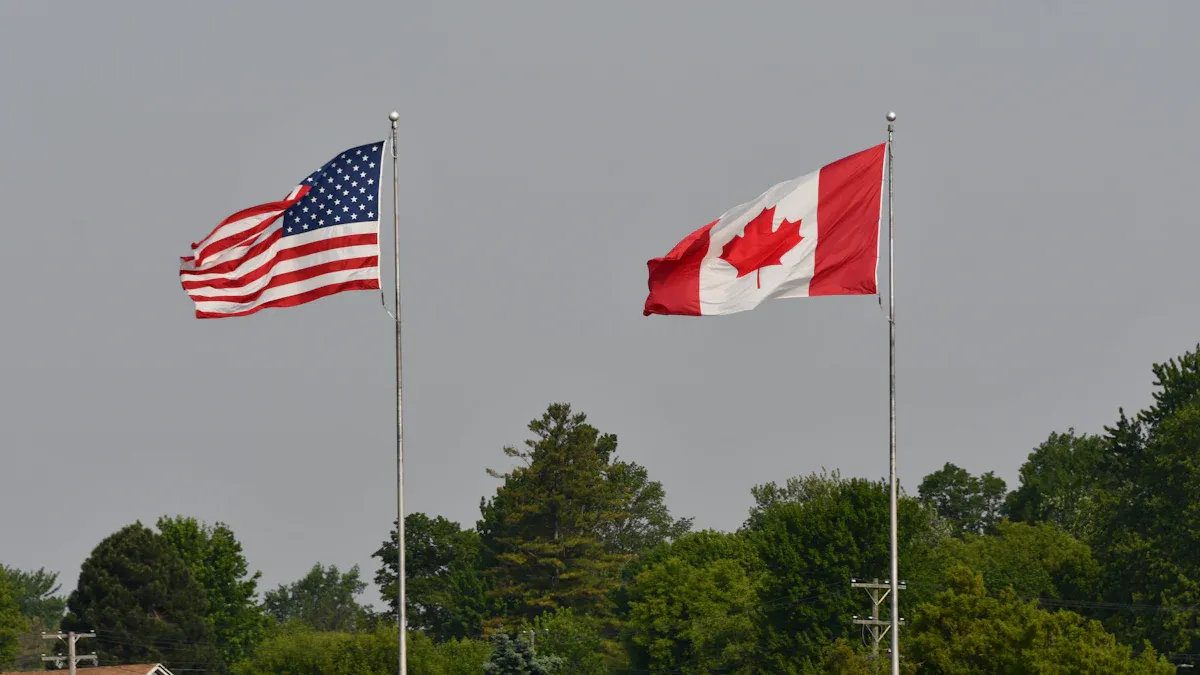
Image Source: pexels
If you plan on traveling from us to canada, you probably want to know what you need before you prepare to cross the us-canada border. Every year, millions of cars make the journey from the united states to canada. The table below shows just how common traveling from us to canada by car is:
| Year | Personal Vehicle Crossings (millions) |
|---|---|
| 2023 | 20.6 |
| 2024* | 13.3 (partial data) |
To help you prepare to cross the us-canada border, here is a quick checklist:
- Passport and required documents
- Car registration and insurance
- Proof of requirements for minors and pets
Border requirements are simple if you get ready in advance. Make sure you meet all requirements to avoid issues at the border.
Key Takeaways
- Always carry valid travel documents like a passport, Enhanced Driver’s License, or NEXUS card to cross the US-Canada border smoothly.
- Keep your vehicle registration and insurance papers handy, and confirm your insurance covers driving in Canada.
- Use official border crossings and be ready to show proof of funds, ties to the US, and answer questions honestly.
- Follow Canadian rules on what you can bring, including limits on alcohol, tobacco, and restricted items to avoid fines.
- Prepare extra documents when traveling with children or pets, and check special rules if you have a criminal record.
Quick Checklist
Essential Documents
You need to gather all required documents before you start traveling from us to canada. Bring your valid passport or passport card. If you have an Enhanced Driver’s License, you can use that instead. Some travelers use a NEXUS card for faster entry. If you are not a U.S. citizen, check if you need a visa. Children must have proof of citizenship, such as a birth certificate or passport. Keep these documents in a safe place that you can reach easily.
Tip: Double-check the expiration dates on your documents. Border officers will not accept expired papers.
Vehicle Papers
You must show proof that you own or can use your car. Bring your vehicle registration and insurance card. Make sure your insurance covers you in Canada. If you drive a rental car, ask the rental company for a letter that allows you to take the car across the border. This letter helps avoid problems at the crossing. Keep all papers together in your glove box.
What to Pack
Pack items that make your trip safe and comfortable. Bring snacks, water, and any medicine you need. Carry a phone charger and a paper map in case you lose cell service. Pack warm clothes, even in summer, because weather can change quickly. If you travel with pets, bring their vaccination records and food. Do not forget your sunglasses and a first-aid kit.
Travel Documents
When traveling from us to canada by car, you must bring the right travel documents. Border officers check these documents to confirm your identity and citizenship. You need to meet all requirements before you can enter canada. This section explains the passport requirements, enhanced driver’s licenses, visa rules, and special rules for children.
Passport or Passport Card
You need a valid passport to enter canada. A valid us passport is the most reliable document for u.s. citizens visiting canada. Border officers prefer a passport because it proves your identity and citizenship. You can also use a passport card for land crossings. The passport card is smaller and fits in your wallet, but you cannot use it for air travel. Both the passport and passport card must be valid and not expired.
Other accepted documents include a certificate of citizenship, a certificate of naturalization, or a certificate of Indian status with photo id. These documents serve as proof of citizenship, but border officers may ask for extra id. A us driver’s license alone does not meet passport requirements for entering canada. You must pair it with a valid passport or other proof of citizenship.
Note: Always check the expiration date on your passport before your trip. Border officers will not accept expired documents.
You do not need an Electronic Travel Authorization (eTA) when entering canada by car if you are a us citizen. You should also keep your car registration and insurance ready, but these do not replace passport requirements.
Enhanced Driver’s License (EDL/EIC)
Some states issue an Enhanced Driver’s License (EDL) or Enhanced Identification Card (EIC). These special licenses meet the requirements for land and sea travel between the united states and canada. EDLs are available only in Michigan, Minnesota, New York, Vermont, and Washington. They include a radio frequency chip and a barcode to speed up border checks.
To get an EDL, you must apply in person at a driver licensing office. You need to prove your us citizenship, identity, and state residency. The staff will take your photo and check your documents. Only us citizens can get an EDL. Green card holders and people with work visas cannot apply. After approval, you will receive your EDL in about two to three weeks.
You can use an EDL instead of a passport when entering canada by car. However, you cannot use it for air travel. Trusted Traveler Program cards, such as NEXUS, SENTRI, or FAST, also meet the requirements for land border crossings. These cards help you cross the border faster if you are enrolled in the program.
Visa Requirements
If you are not a us citizen, you must check the immigration requirements before you enter canada. Most non-us citizens need a valid passport and a visitor visa to enter canada by car. The Canadian government does not accept an eTA for land travel. You must show your valid passport and visa at the border.
If you live in the us as a permanent resident, you must carry your green card and your passport from your home country. You may also need to show proof of your legal status in the us, such as a permanent resident card or other documents. If you hold a visa like J-1, H-1B, or F-1, you must bring your visa documents, such as DS-2019, I-797, or I-20, with travel endorsements.
Some visa holders can use the Automatic Revalidation program. This program lets you re-enter the us after a short trip (less than 30 days) to canada, even if your us visa has expired. You must have all your documents in order and not apply for a new visa during your trip. If your visit to canada lasts longer than 30 days, you must get a new us visa before you return.
Tip: Always print a copy of your Form I-94 before you leave the us. You need this form to re-enter the united states.
Children’s Documents
Children under 16 have special passport and visa information rules when entering canada by car. They do not need a passport, but it is the best document to use. Children can also use an original or certified copy of their birth certificate, a certificate of naturalization, or a consular report of birth abroad as proof of citizenship.
If a child travels with only one parent, a guardian, or someone else, you must bring extra documents. You need a notarized letter of consent from the non-traveling parent or legal guardian. This letter should state that the child has permission to travel and include travel dates. If parents are divorced or separated, bring custody papers and a letter from the other parent. If one parent is deceased, bring a copy of the death certificate.
Note: Border officers may ask for these documents to make sure the child has permission to travel. Having all the right papers helps avoid delays.
Always keep children’s travel documents and consent letters in a safe place. These requirements help protect children and make your border crossing smoother.
Vehicle Requirements
Registration and Insurance
When you drive your own car from the US into Canada, you must carry proof of registration and insurance. Keep your vehicle registration card in your glove box. Border officers will ask to see it when you cross from the United States into Canada. Your US auto insurance usually covers you while you visit Canada for a short time. Before your trip, call your insurance company to confirm that your policy meets Canadian requirements. Some insurance companies will give you a special card called a Canadian Non-Resident Insurance Card. This card proves your coverage works in Canada and can help you avoid problems at the border.
Tip: Always keep your insurance card and registration together. If you lose them, you may face delays or even be denied entry.
If you plan to stay in Canada for more than 90 days, you may need extra insurance or an International Driving Permit. Each province in Canada has its own rules, so check before you go. Make sure your documents are up to date and easy to find.
Rental Cars
You can drive a rental car from the US into Canada, but you must follow special requirements. Before you leave, tell the rental company you plan to cross the border. They must give you written permission to take the car into Canada. Without this letter, border officers may not let you enter. Always carry your rental agreement and the letter from the rental company.
Here is a checklist for driving a rental car into Canada:
- Notify the rental company and get their written permission.
- Carry your passport and US driver’s license.
- Bring proof of insurance. Ask the rental company for a Canadian Non-Resident Insurance Card if needed.
- Keep your rental agreement and all paperwork with you.
- Be ready to explain that your trip is temporary. Customs officers may ask questions to make sure you do not plan to import the car.
- Make sure all documents are complete to avoid extra inspections.
Rental agencies do not pay for any fines or legal fees you get in Canada. You must follow all Canadian laws while driving to Canada. If you do not have the right documents, border officers may turn you back or hold you for more questions.
Local Driving Laws
Driving in Canada feels familiar, but some rules are different from the US. You must pay close attention to speed limits. In Canada, speed limits use kilometers per hour, not miles. For example, a sign that says 100 means 100 km/h, which is about 62 mph. Road signs may be in English, French, or both. In Quebec, many signs are only in French.
Some important differences to remember:
- Right turns on red lights are allowed in most of Canada, but not in Montreal.
- All passengers must wear seatbelts. Children need car seats until they are nine years old or reach 145 cm in height.
- You must use hands-free devices if you talk on your cell phone while driving.
- Smoking in cars with children is banned in many provinces.
- Toll roads are rare, but Ontario’s 407 ETR uses automatic billing.
- Canadian police enforce strict DUI laws. The legal blood alcohol limit is 0.08%. Penalties are serious.
- Winter driving can be dangerous. Snow and ice are common, so check the weather and carry emergency supplies.
You can use your valid US driver’s license and insurance for up to 90 days in most provinces. If you plan to stay longer or rent a car for an extended period, you may need an International Driving Permit and extra insurance. Always follow local laws to avoid fines or other problems.
Note: Learn the local rules before you start driving to Canada. This helps you stay safe and avoid surprises.
Border Requirements
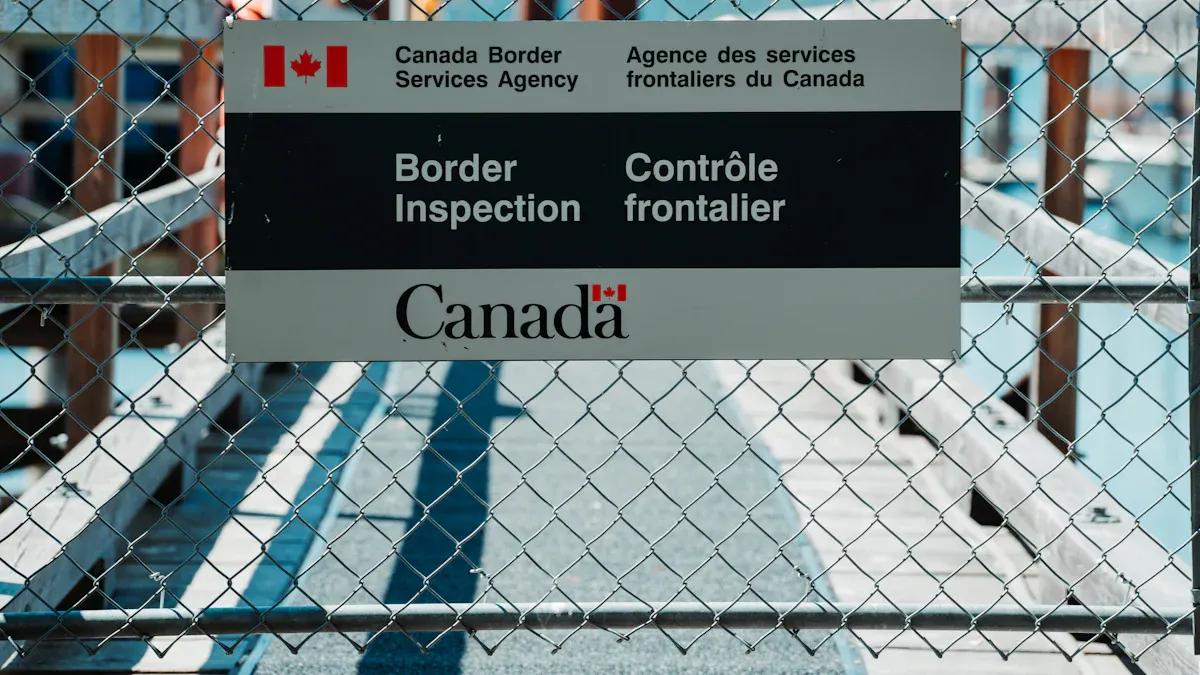
Image Source: unsplash
Official Crossing Points
When traveling from us to canada by car, you must use an official border crossing. The us and canada share more than 100 official land border crossings. Each state along the border has its own number of entry points. The table below shows how many official us-canada border crossings each state has:
| US State | Number of Official Land Border Crossings |
|---|---|
| Washington | 13 |
| Idaho | 2 |
| Montana | 13 |
| North Dakota | 18 |
| Minnesota | 8 |
| Michigan | 4 |
| New York | 17 |
| Vermont | 15 |
| New Hampshire | 1 |
| Maine | 24 |
| Total | More than 100 |
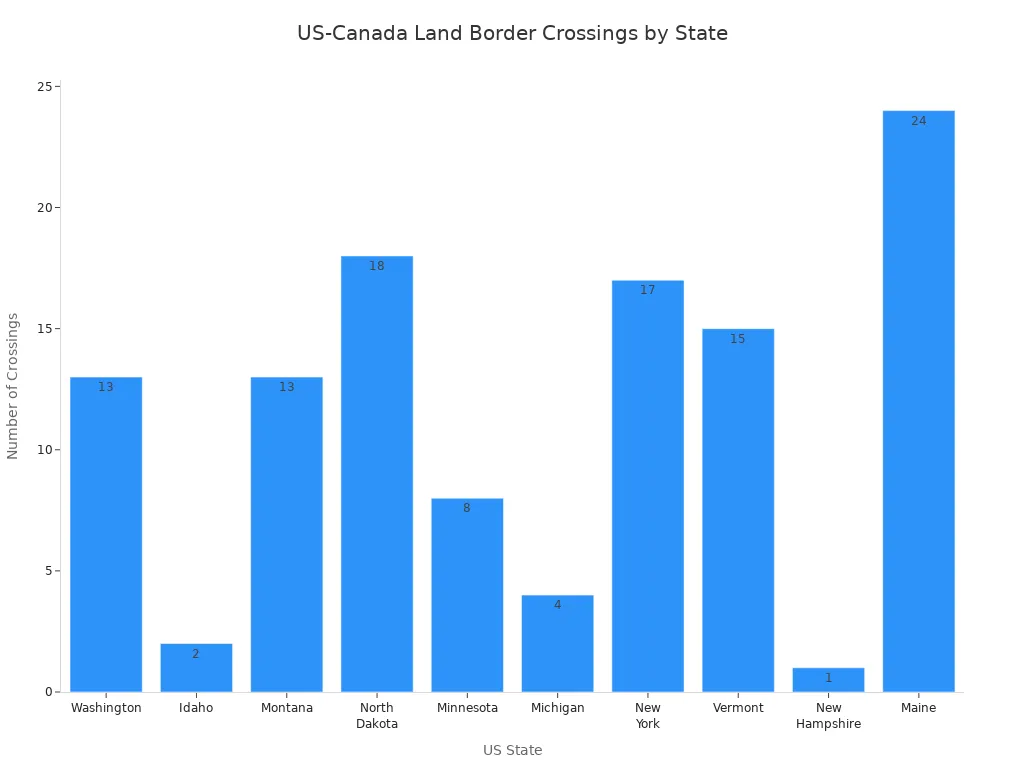
You must choose an official crossing point when you cross the border. Unofficial crossings are illegal and can lead to fines or arrest. Always check the hours of operation before you go, because some crossings close at night or on holidays.
Proof of Funds and Ties
Border requirements include showing that you have enough money for your trip and strong ties to the us. When entering canada, border officers may ask for proof that you can support yourself and that you plan to return to the us. You can use several types of documents to meet these requirements:
| Requirement Category | Examples of Evidence Provided |
|---|---|
| Proof of Financial Support | Bank statements, passbooks |
| Income Verification | Recent and past income tax records |
| Employment Evidence | Recent pay stubs, employment ID, employer letter |
| Proof of Residence | Rent receipts, mortgage documents, utility bills |
| Confirmed Means of Departure | Bus, train, or airline ticket with date |
| Destination Information | Address, phone number, name of person visited |
| Ties to Country of Origin | Job, home, family |
Border officers want to see that you have a job, a home, or family in the us. They may also check your travel plans and ask about your destination in canada. You must answer all questions honestly. Officers can search your car and belongings as part of the border requirements.
Border Wait Times
Border wait times can change quickly. When crossing the canadian border, you may wait only a few minutes or up to two hours. Many factors affect wait times, such as the time of day, holidays, weather, and the crossing location. Here are some facts about border wait times:
- Wait times at us-canada border crossings range from a few minutes at small crossings to two hours at busy ones like Niagara Falls during holidays.
- Most travelers should plan for at least 45 minutes to cross the border by car.
- Peak times, such as weekends and holidays, often have longer waits.
- Airport customs lines are usually shorter, with waits from 15 to 90 minutes.
You can check live wait times online before you travel. Planning ahead helps you avoid long delays and makes your trip smoother.
What to Bring
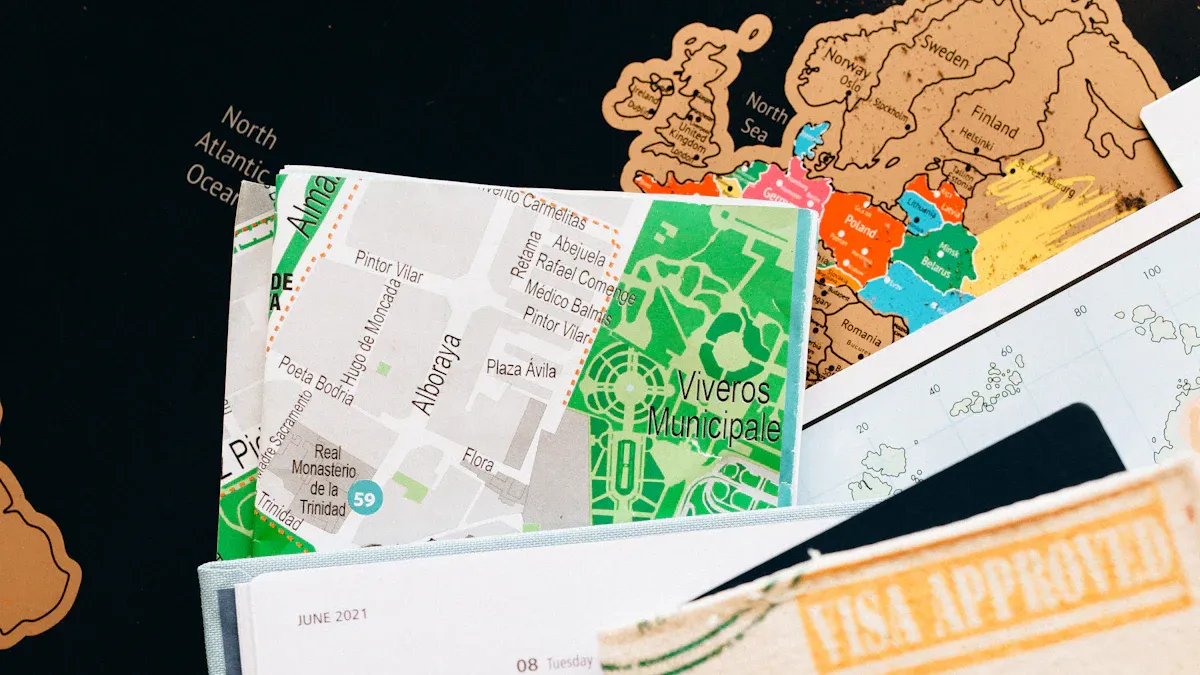
Image Source: pexels
Food, Alcohol, Tobacco
When you travel from the US to Canada by car, you must follow strict rules about what you can bring. You can bring some food for personal use, but you should avoid fresh fruits, vegetables, and animal products. These items often face restrictions to protect local farms and the environment.
Alcohol and tobacco have clear limits. You can bring a set amount duty-free if you meet the age requirement in the province you enter. The table below shows the maximum amounts you can bring without paying extra taxes:
| Product Type | Maximum Duty-Free Quantity | Approximate Equivalent |
|---|---|---|
| Wine | Up to 1.5 liters | Two 750ml bottles |
| Liquor/Spirits | Up to 1.14 liters | One large bottle |
| Beer or Ale | Up to 8.5 liters | About 24 cans/bottles (355ml) |
| Tobacco Product | Duty-Free Limit |
|---|---|
| Cigarettes | 200 cigarettes |
| Cigars | 50 cigars |
| Manufactured Tobacco | 200 grams (7 ounces) |
| Tobacco Sticks | 200 sticks |
You must declare all alcohol and tobacco at the border. If you bring more than the allowed amount, you will pay duty and taxes.
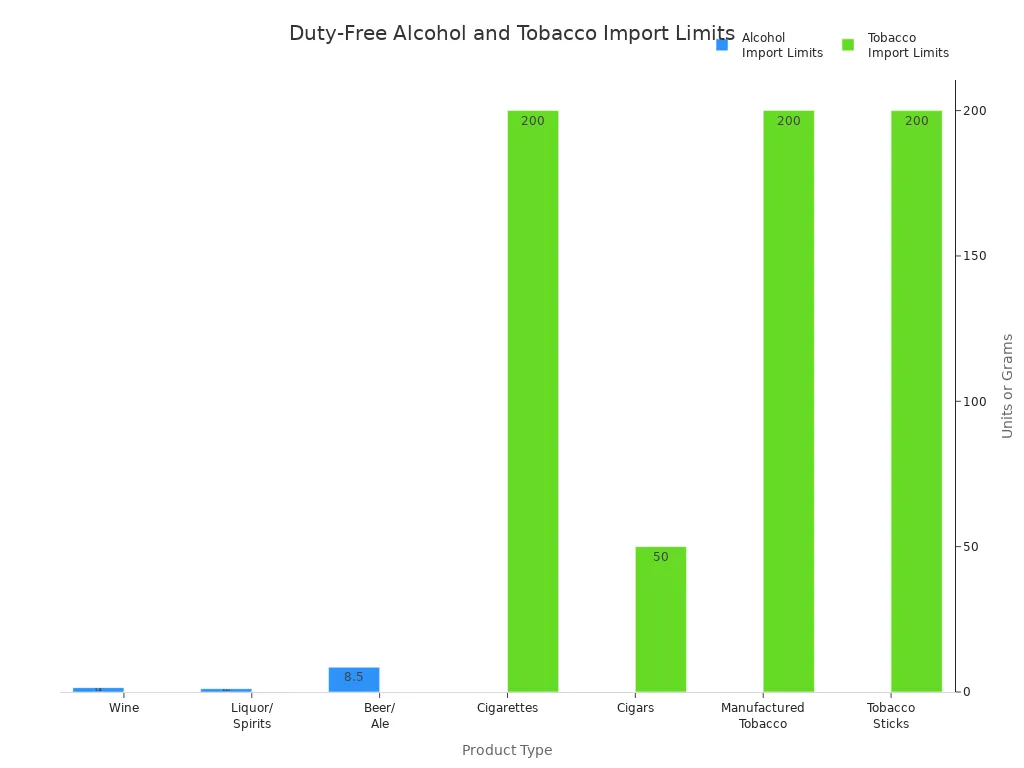
Restricted Items
Canada has many rules about what you can bring across the border. Some items are not allowed at all. Others need special permits or must meet strict conditions. Here are some of the most common restricted or prohibited items:
- Fresh fruits and vegetables, especially apples, cherries, citrus, potatoes, and tomatoes
- Certain plant materials, like grapevines, chestnuts, and sugarcane
- Soil, unless you have a permit
- Firewood
- Meat and animal products
- Live animals without proper paperwork
- Firearms and weapons, including pepper spray and brass knuckles
- Products with dog or cat fur
- Counterfeit goods and cultural artifacts without permits
- Medication not prescribed for personal use
- Radar detectors and obscene materials
You should always check the latest rules before your trip. If you are unsure about an item, declare it at the border.
Duty-Free Limits
Duty-free limits depend on how long you stay outside Canada. If you stay less than 24 hours, you cannot claim any duty-free goods. For trips of 48 hours or more, you can bring up to $800 USD worth of goods, including alcohol and tobacco, without paying duty. The table below explains these limits:
| Duration of Absence | Duty-Free Exemption | Alcohol Limits | Tobacco Limits |
|---|---|---|---|
| Less than 24 hours | No exemption | None | None |
| 24-48 hours | Up to $200 USD (no alcohol/tobacco) | None | None |
| 48 hours or more | Up to $800 USD (includes alcohol/tobacco) | See above | See above |
If you exceed these limits, you must pay duty and taxes on the extra goods. Always keep your receipts and be ready to show them at the border.
Special Cases
Traveling with Children
When you travel with children across the US-Canada border by car, you must bring the right documents. Children under 16 who are US or Canadian citizens can use a state-issued birth certificate as proof of citizenship if both parents travel in the same vehicle. A passport is always preferred, but a birth certificate works for land crossings. Canadian law asks for proof of citizenship and identity. For adults, you need a valid US passport, passport card, or NEXUS card. Children under 16 only need proof of citizenship.
Here is a quick guide to required documents:
| Scenario | Required Documents or Actions |
|---|---|
| Child under 16 with both parents | Birth certificate, passport, or citizenship card |
| Traveling with one parent | Consent letter from the other parent (original preferred) |
| Divorced parents with shared custody | Legal custody documents and authorization letter |
| Legal guardianship | Court order granting guardianship |
| One parent not on birth certificate | Certified copy of birth certificate |
| Deceased parent | Certified copy of death certificate |
| Groups (school, sports, etc.) | List of children, supervising adult, and parental consent on organization letterhead |
Border officers may ask questions about your relationship to the child. You should travel in the same vehicle as your children. Call the border crossing ahead if you have questions about documents.
Traveling with Pets
You can bring your pets with you when you drive from the US to Canada, but you must follow health and vaccination rules. Dogs over three months old need proof of a current rabies vaccination. Cats over three months also need a rabies certificate. Puppies and kittens under three months do not need this proof. Ferrets should have a rabies certificate, but it is not required. Birds need a health certificate and must follow special travel routes.
| Pet Type & Age Group | Health Certificate Requirement | Rabies Vaccination Requirement | Additional Notes |
|---|---|---|---|
| Dogs under 8 months | Health certificate if unaccompanied; not needed if with owner | Rabies certificate if over 3 months (except assistance dogs) | Unaccompanied puppies need vet exam within 72 hours of arrival |
| Dogs 8 months or older | Not required | Rabies certificate required for all dogs over 3 months | Applies to up to two pet dogs with owner |
| Cats | Not required | Rabies certificate required for cats over 3 months | Certificate must show date and vaccine type |
| Ferrets | Not required | Rabies certificate recommended for ferrets over 3 months | Can vaccinate on arrival if needed |
| Birds | Health certificate and route documentation required | Not applicable | Must use approved travel routes |
Keep all pet documents with you. Make sure your pet’s rabies certificate lists the date and vaccine type.
Criminal Record
Canada has strict rules for travelers with a criminal record. Border officers check US criminal databases and may deny entry if you have certain offenses. You should know these important facts:
- Canada treats offenses like DUI, reckless driving, theft, assault, and drug crimes as serious.
- Even one DUI can make you inadmissible.
- You may need a Temporary Resident Permit (TRP) for short visits, which allows entry for up to three years.
- Criminal Rehabilitation offers a permanent solution if you finished your sentence at least five years ago.
- Some people with a single misdemeanor may be allowed entry after ten years, but this does not apply to serious crimes.
- Sealed or expunged records may still count in Canada.
- You should seek legal advice and apply for a TRP or Criminal Rehabilitation before you travel if you have a record.
Travelers with a criminal record should prepare before reaching the border to avoid being turned away.
Border Crossing Information
What to Expect
When you reach the border, you follow a clear process. First, you stop at the inspection booth and present your documents. You need a valid passport, Enhanced Driver’s License, or NEXUS card to prove your identity and citizenship. Border officers from the US or Canada will ask about your travel plans and may check your car. They look for restricted items and ask questions about your trip. Sometimes, they inspect your vehicle or luggage. If you use a NEXUS card, you can use a special lane for faster entry, but you must meet all requirements.
Here is a step-by-step guide to the border crossing process:
- Show your travel documents to the officer.
- Answer questions about your trip and items you carry.
- Allow officers to inspect your car if they ask.
- Follow all instructions and stay calm.
Tip: Keep your documents and any paperwork within easy reach. This helps speed up the process.
Declarations
You must declare certain items when you enter Canada from the US. Always tell the officer about goods you bought outside Canada, even if you plan to keep them. Some items require special attention:
- Firearms, weapons, or pepper spray
- Food, plants, seeds, and animal products
- Commercial goods, tools, or equipment
- Currency over $10,000 USD
- Cannabis or products with cannabis
- Gifts, prizes, or duty-free items
- Repairs or work done outside Canada
Personal items for your own use usually do not need to be declared unless they are restricted or valuable. If you are not sure about an item, declare it. Honest answers help you avoid fines or delays at the border.
Note: Customs officers decide what you must declare. Always answer truthfully and clearly.
Currency Exchange
Currency exchange is an important part of border crossing information. Exchange rates between the US dollar and the Canadian dollar change often. Banks and ATMs near the border usually offer better rates than kiosks or hotels. If you pay in US dollars in Canada, you may face extra fees or poor rates. Try to convert some money at a bank before your trip. Using credit cards without foreign transaction fees can save you money. Cross-border banking services, like those from RBC, let you move funds between US and Canadian accounts with low fees and good rates. You can also use online tools to watch exchange rates and plan the best time to convert your money.
Tip: Always pay in the local currency to avoid extra charges. Check the latest rates before you travel.
Re-entering the US
Return Documents
When you drive back into the United States from Canada, you must show the right documents at the border. Border officers will check your identity and your citizenship. You should keep your documents ready and easy to reach. The list below shows what you need:
- Passport or U.S. Passport Card
- Trusted Traveler Cards (NEXUS, SENTRI, FAST)
- Enhanced Driver’s License (EDL) or Enhanced Identification Card (EIC)
- Military ID or Merchant Marine Document (with special conditions)
- Enhanced Tribal Card
- For children under 15, a birth certificate or other proof of citizenship may be accepted
If you are not a U.S. citizen, you must show a valid passport. Lawful Permanent Residents need to present their Permanent Resident Card (Form I-551). Canadian citizens can use an Enhanced Driver’s License, Enhanced Identification Card, or Trusted Traveler Card. Children under 16 may use a birth certificate or proof of citizenship.
You must also have your valid driver’s license and vehicle registration. These papers show you own or can use the car. Officers may ask to see them to make sure the car is not stolen.
Tip: Keep all your documents together in a folder or pouch. This helps you move through the border faster.
Duty-Free Allowance
When you return to the United States, you can bring back goods up to a certain value without paying duty. The amount depends on how long you stayed in Canada. The table below shows the main duty-free limits:
| Length of Stay in Canada | Duty-Free Limit (USD) | Alcohol Limit | Tobacco Limit |
|---|---|---|---|
| Less than 48 hours | $200 | None | 50 cigarettes, 10 cigars |
| 48 hours or more | $800 | 1 liter | 200 cigarettes, 100 cigars |
You must declare all goods you bring back, even if they are under the limit. If you go over the duty-free allowance, you will pay duty and taxes on the extra items. Keep your receipts to show what you bought.
Note: Some items, like fresh fruits, meats, and plants, have special rules. Always check the latest guidelines before you travel.
Before you leave the US, review your checklist: valid passport, vehicle papers, and all border requirements. Many travelers forget to check car fluids or underestimate travel time between destinations. Stay calm and answer border questions honestly. Use real-time resources to check wait times. For a smooth trip, remember these essentials:
- Prepare all documents and consent letters.
- Confirm insurance and registration.
- Know what you can bring across the border.
Ask questions or share your tips below!
FAQ
Do you need a COVID-19 test to cross the US-Canada border by car?
You do not need a COVID-19 test to enter Canada by car. Canada removed testing and vaccination requirements for travelers. Always check for updates before your trip, as rules can change quickly.
Can you drive a leased car from the US to Canada?
Yes, you can drive a leased car into Canada. You must bring a letter of permission from the leasing company. Keep your lease agreement and insurance card with you at all times.
What happens if you forget your passport at the border?
Border officers will not let you enter Canada without proper documents. If you forget your passport, you must return to the US and get it. Always check your documents before you leave home.
Can you bring prescription medication into Canada?
You can bring prescription medication for personal use. Keep medicine in its original packaging with your name and prescription label. Bring a copy of your doctor’s note if possible. Declare all medication at the border.
How do you pay tolls in Canada?
Some Canadian highways use electronic tolls. For example, Ontario’s 407 ETR sends a bill to your address. You can pay online or by mail in USD, based on the current exchange rate. Check the toll road’s website for payment options.
Crossing the US–Canada border by car is easier when you have the right documents ready, but don’t forget about your travel finances. Many travelers face hidden costs when exchanging money or paying abroad. With BiyaPay, you can simplify your trip.
BiyaPay offers real-time exchange rates, remittance fees as low as 0.5%, and supports seamless conversion between multiple fiat and digital currencies. Whether you need to cover expenses in Canada, send money back home, or manage multi-currency balances, BiyaPay helps you avoid unnecessary charges. With same-day settlement, global coverage, and fast registration, your travel funds stay flexible and secure.
Plan your road trip with confidence and keep your cross-border payments hassle-free. Start today by registering at BiyaPay.
*This article is provided for general information purposes and does not constitute legal, tax or other professional advice from BiyaPay or its subsidiaries and its affiliates, and it is not intended as a substitute for obtaining advice from a financial advisor or any other professional.
We make no representations, warranties or warranties, express or implied, as to the accuracy, completeness or timeliness of the contents of this publication.




Contact Us
Company and Team
BiyaPay Products
Customer Services
is a broker-dealer registered with the U.S. Securities and Exchange Commission (SEC) (No.: 802-127417), member of the Financial Industry Regulatory Authority (FINRA) (CRD: 325027), member of the Securities Investor Protection Corporation (SIPC), and regulated by FINRA and SEC.
registered with the US Financial Crimes Enforcement Network (FinCEN), as a Money Services Business (MSB), registration number: 31000218637349, and regulated by FinCEN.
registered as Financial Service Provider (FSP number: FSP1007221) in New Zealand, and is a member of the Financial Dispute Resolution Scheme, a New Zealand independent dispute resolution service provider.



















